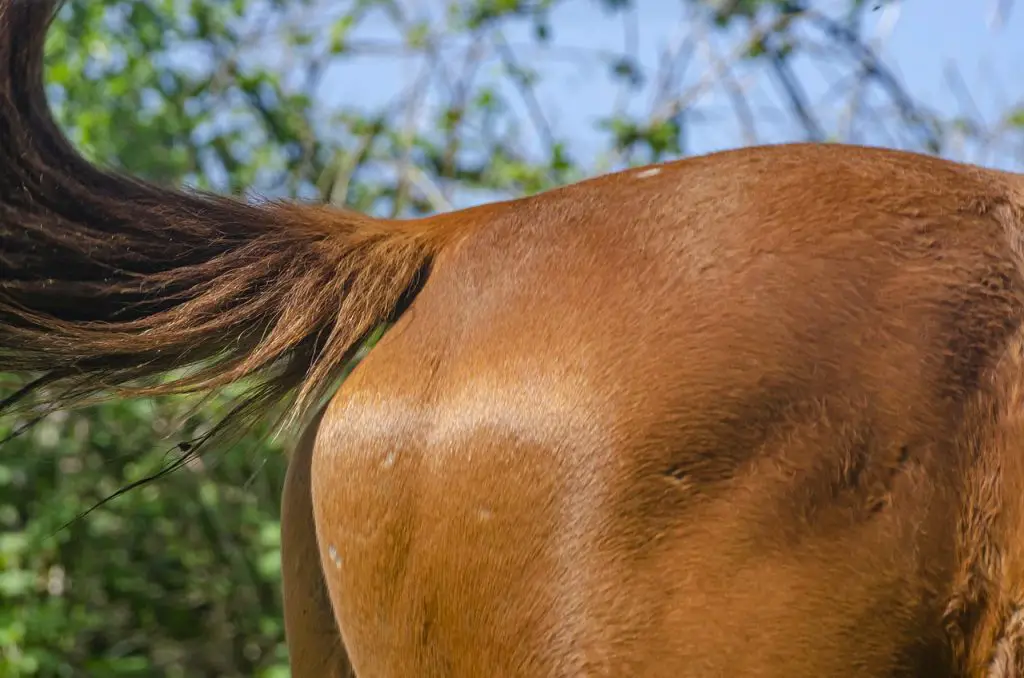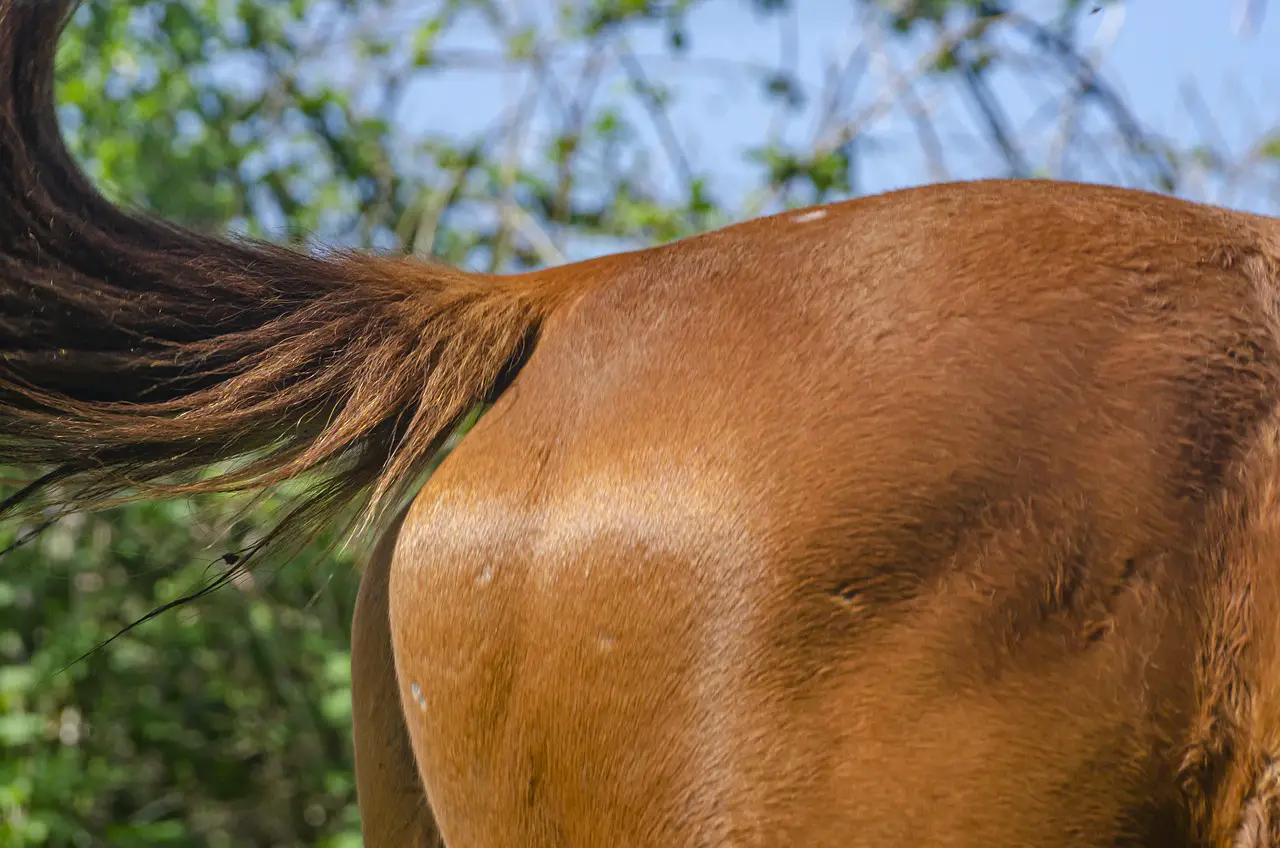Last Updated on February 25, 2022 by Allison Price
Sacroiliac Disease can affect any horse and cause subtly reduced performance
Your horse is bounding along his paddock, turning out after turnout. You giggle, thinking about how your horse looks like a rabbit with the way his hind feet touch in a hopping motion every step. However, what you are seeing is not a laughing matter. Equine researchers worldwide are looking into the signs of performance-limiting conditions such as bunny-hopping, hindquarter coordination problems, weight shifting, and difficulty lifting the hind foot for hoof care.
Sacroiliac disease, which has only been documented in literature since 2003, is a relatively recent field of scientific research. The advancements made by researchers are improving the recognition, diagnosis, prevention, treatment and overall understanding of this musculoskeletal issue.
Anatomy of Sacroiliac Region
The sacroiliac region (SI), is the area of the horse’s back that, as it sounds, connects the sacrum to the ilium. The pelvis’ largest fan-shaped bone, the ilium, is located in the sacroiliac (SI) region. The sacrum is also part of the pelvis and is composed of five fused vertebrae, which form one solid unit right before the tail.
Rob van Wessum DVM, MS and Dipl. explains that these bony structures are connected by two SI joints, and that a series ligaments runs along the central side of the joints holds them together. ACVSMR Cert Pract KNMvD Equine, of Equine All-Sports Medicine Center in Mason, Michigan.
This SI region transfers the horse’s hind legs and back forces to enable him to move forward quickly. The SI region, unlike other joints and ligaments found in horses’ bodies, is more designed for stability and shock absorption rather than movement.
What’s the Deal?
Van Wessum says that SI disease can strike one or more structures in the area. Ligaments can become torn, stretched or damaged. Additionally, arthritic changes can occur. He says that most of the time it is ligament damage that was not initially recognized. “But if the damage is severe, arthritis can develop in the joints as they are no longer supported by their ligaments.”
He says that ultrasound and scintigraphy (bone scanning) might show changes in ligament fiber patterns and lesions in the connections between bone and ligament. Sometimes bones can become rough and even have signs of fracture or avulsion, which is when a ligament pull or tendon pull causes a bone to break off. Long-term injury to ligaments can cause them to become more rigid. Van Wessum says that these types of changes can cause a horse to become very crooked over time.A bone scan can help diagnose SI disease. Here, the brighter area around the SI joint in the right image reveals bone remodeling activity that indicates a positive diagnosis. | Photo: Courtesy Rob van Wessum, DVM, MS
The Culprits: Wear and Injury
Sacroiliac diseases can occur in horses of any age. Van Wessum explains that horses can slip or fall and stretch their ligaments. “And since they don’t give very clear lameness, their owner doesn’t know it and continues to work the horse.”
Concurrent injuries are most common to the top of the hind supensory ligaments running down the back of each cannon bones, according to Sue Dyson, MA VetMB, DEO and FRCVS, head Clinical Orthopaedics at Newmarket’s Animal Health Trust Centre For Equine Studies.
She says that secondary SI joint pain is often caused by their altered movement due to pain in their hind legs.
She suggests that conformation could also be a major cause. SI disease is more common in horses that have been built “downhill”, meaning they have their withers lower than the jumper’s bump (the highest point of their croup). She says that she suspects that this is a risk factor, but that more research is needed to confirm her suspicions.
Dyson says that SI disease can also be caused by how we train. The condition seems to have become more prevalent over the past 30 years due to changes in training methods. She says that horses are being trained in a new way today. “More horses are being used in single disciplines. Many horses are used in arenas, and not in different situations. These can cause wear and tear to the horse’s body. Horses that are asked to move in circles all the time are not performing their original purpose. I believe it also affects their mental health.
Signs that there is a problem
How can you tell if your horse is suffering from SI pain? Although a veterinarian cannot diagnose SI pain, there are some signs that could indicate it.
Lameness isn’t one of these. Our sources claim that horses can become disabled from SI disease. Most horses aren’t.
Reduced performance is the most obvious sign, but it can also be a sign that there are other conditions. Van Wessum states that many horses don’t want the forward movement. “Or they will be uneven in or have a decreased capacity for some exercises, or they will be less symmetrical as before, such as when they turn or pirouette.”
Many of these horses don’t want the freedom to move forward.Dr. Rob Van WessumDyson concurs, adding that although some horses may show “genuine asymmetry as an actual asymmetry”, it’s more common for them to lack “hind-limb impulsion or engagement.”
You might find it difficult to canter, or even lope. The slowness of their gait may cause additional difficulties. Van Wessum states that their rhythms change. Van Wessum says that they can have a three-beat canter and then go offbeat or even appear ataxic (uncoordinated). The sign of a SI-affected horse’s condition is the bunny hop canter with the back legs almost moving together.

Dyson states that conflict behavior can also indicate a horse’s discomfort under saddle.
Dyson states that although clinical signs of the disease are not always apparent until the horse is ridden Dyson suggests that the horse may still feel some discomfort on the ground.
Van Wessum states that horses can become crabby, particularly if they have a disease that affects their joints. This can cause constant and moderate pain. They may also shift their weight frequently in the stall. He also says that these horses might be difficult for farriers to stand. He says that lifting one leg means standing on the other. This is why they can become unruly or even kick the farrier.
Van Wessum says that palpating the SI area for pain testing won’t give any clues. Van Wessum says that the diseased structures are so deep in the back that it is unlikely that we will be able to push on the horse with our hands. (To learn more about van Wessum’s research on SI disease signs, visit TheHorse.com/35554.
Supporting Healthy SI
How can you ensure your horse’s SI is healthy? First, choose horses that are sound in conformation and have withers higher than the knees. This is Sue Dyson, MA. VetMB, DEO. FRCVS, Head of Clinical Orthopaedics at Newmarket’s Animal Health Trust Centre for Equine Studies. Core muscle strengthening and stability training are both important, as described in Activate Your Horse’s Core by Narelle Stubbs & Hilary Clayton. You can mix up your exercise routine by including outdoor work. After any type of injury, be sure to watch your behavior and movements.
Your veterinarian should be contacted immediately if you feel the hippity-hoppity canter. A full recovery is possible if the healing process begins as soon as possible.
—Christa Leste-Lasserre, MA
Contrary Diagnoses
Sacroiliac disease can be mistaken for other conditions. Van Wessum states that owners and veterinarians mistakenly believe they are seeing conditions like hock arthritis, ataxia, or stifle. Sometimes they will recognize it as back pain. But, they may not always find the correct location. He says that many horses who come to our clinic have had three or four diagnostics.
The treatment will not be effective if the diagnosis is incorrect. Horses can be treated with massages, injections, shock wave therapy, needle therapy and acupuncture to treat their condition. Van Wessum states that as long as the correct diagnosis is not made, all of these treatments will fail.
These efforts can actually delay diagnosis and leave the problem untreated.
Physical Therapy and Other Treatments
Sacroiliac disease can be treated with non-surgical techniques. Van Wessum says that although the prognosis for sacroiliac disease is better if it is detected early, chances of regaining athletic performance are still good. Van Wessum has seen more than 90% of the horses who have been treated for this condition return back to their previous level of work.
Dyson suggests that horses who have been suffering from poor performance for more than a year could pose greater treatment challenges.
A physical training program tailored to each horse is the best treatment. Different structures can be affected in different ways. A veterinarian can create a program that will bring healing and relief in the correct order at the right time.
Van Wessum states that treatment usually begins with stall rest, anti-inflammatories and a calming environment. Dyson adds that primary causes such as hind-limb injuries should be addressed by the veterinarian. Van Wessum may inject corticosteroids by using a particular technique to reach inflamed SI joints.
Exercise is the key to healing the SI region. Dyson says, “We put them into a nonridden… program, working as closely as we can (e.g. in a Pessoa-rig).” We encourage them to use poles on the ground and we also encourage them to do so. We put them back under saddle when we feel they are making progress. Then we get them to work on the things that they find easy.
Van Wessum organizes some of the ridden work around Dressage Exercises. He is a FEI-level dressage judge and rider. This is especially important for horses with SI issues, who require stability and core strength.
Dyson says that core training is crucial to building topline muscles. SI-affected horses often lose their core strength when they try to reduce discomfort. She says, “You can get into a vicious circle because if they aren’t using the muscles, then those muscles are wasting away and then they don’t have the support so they lose the core stability.”
Van Wessum states that rehabilitation can take anywhere from six weeks to six years, depending on how severe the disease is and what structures are involved.
Do Not Try It at Home
You might think, “Just some core training? And gradual dressage work?” “Great! “Great!
Wrong.
Sacroiliac rehabilitation is not just a customized program and skills from a specialized veterinarian, but also requires a precise diagnosis.
Van Wessum states that the veterinary evaluation will include a complete client history including behavioral problems and a physical exam. Then, ultrasound and scintigraphy should be performed.Dyson says that a ridden lameness examination is mandatory. She says, “You must see the horse ride.” “Unless he is too weak to ride, we see all horses ridden.”
After the veterinarian has confirmed the diagnosis through a thorough physical exam and scintigraphy, the vet may refer the horse or pony to a specialist in sports medicine. They can then devise a stepwise treatment plan for your horse’s recovery.
Van Wessum states that you need to have a complete picture of the situation. “The approach to each case is different.”
This approach should be taken by a vet who has experience with SI disease. You might need to be referred to a clinic that has a reputation for treating this condition.
It doesn’t matter what your diagnosis is, you can’t manage it with your own treatment. Van Wessum states, “It is very difficult to say… ‘I’ll try this program to get him better.’ “You are likely to be very disappointed.”
Take-Home Message
Sacroiliac disease is debilitating and performance-limiting. Inefficient treatment can result in poor welfare and behavior problems for your horse, especially if you consider the condition to be behavior-related. Learn how to recognize these signs and consult your veterinarian for a diagnosis.



